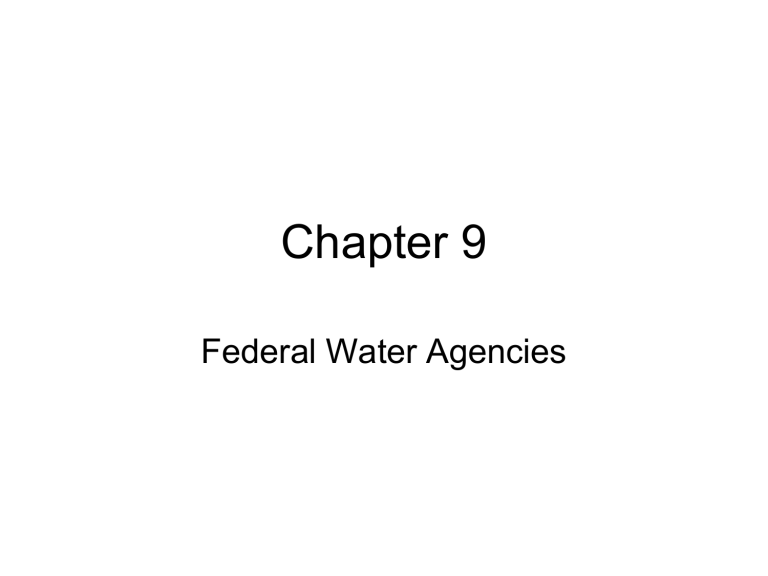Chapter 9 - UGA Hydrology

Chapter 9
Federal Water Agencies
Chapter Headings
• U.S. Army Corps of Engineers
• U.S. Bureau of Reclamation
• U.S. Geological Survey
• U.S. Fish and Wildlife Services
• National Park Service
• Bureau of Land Management
• U.S. Environmental Protection Agency
• Natural Resources Conservation Service
• U.S. Forest Service
• Federal Energy Regulatory Commission
• National Marine Fisheries Service
• Federal Emergency Management Agency
Chapter Headings
• U.S. Army Corps of Engineers
• U.S. Bureau of Reclamation
• U.S. Geological Survey
• U.S. Fish and Wildlife Services
• National Park Service
• Bureau of Land Management
• U.S. Environmental Protection Agency
• Natural Resources Conservation Service
• U.S. Forest Service
• Federal Energy Regulatory Commission
• National Marine Fisheries Service
• Federal Emergency Management Agency
US Army Corps of Engineers (COE)
• Founded in 1794
• Early history in removing snags and building levees on the Mississippi
– Average lifespan of a steamboat in 1800’s was less than 2 years
• Great Mississippi River Flood of 1927 stimulated federal role in flood control
– Peak discharge of 2.5 million cfs
– 200 people killed and 600,000 left homeless
– Flood Control Acts of 1928 and 1936
– 1936 law required cost-benefit analysis
Mississippi Flood 1927
Mississippi Flood 1927
U.S. Army COE: Dams
• Until 1930’s primary activity was flood control and navigation in Eastern States
– Most navigable rivers are in the East
– 230 locks
• Federal government began large western dam-building program during Great
Depression
– Hoover Dam completed in 1935
– Part of purpose was to provide employment
U.S. Army COE: Dams
• COE began to compete with Bureau of
Reclamation (USBR) for western dam projects
– Primary purpose was irrigation
– Flood control and navigation was secondary
• Example is Garrison Dam on the Missouri River in North Dakota
– USBR had determined that it was uneconomical
– Dam would inundate Fort Berthold Indian Reservation land
– COE redid cost-benefit analysis and lobbied Congress to approve project
– Approved in 1944 for construction by COE
U.S. Army COE: Wetlands
• Early federal laws encouraged draining of swamps for navigation and disease control
– Swamp Lands Act of 1850 and 1860
• Clean Water Act Amendments 1972 provided protection of wetlands (swamps)
– Section 404 required COE approval of any development that would alter or destroy a wetland
Chapter Headings
• U.S. Army Corps of Engineers
• U.S. Bureau of Reclamation
• U.S. Geological Survey
• U.S. Fish and Wildlife Services
• National Park Service
• Bureau of Land Management
• U.S. Environmental Protection Agency
• Natural Resources Conservation Service
• U.S. Forest Service
• Federal Energy Regulatory Commission
• National Marine Fisheries Service
• Federal Emergency Management Agency
U.S. Bureau of Reclamation
• John Wesley Powell (1834-1902)
– Promoted federal role in irrigation projects
• Founded by Reclamation Act of 1902
– Purpose to provide water to promote settlement of arid western states
– Irrigation water initially limited to farms < 160 acres
– Construction costs to be repaid by farmers
– Local irrigation districts set up to control finances
• Early success in making small projects pay
• Later large projects catered to corporate farms and special interests
– Acre limits were ignored and local districts did not collect finances
– Hoover Dam in 1935 and Grand Coulee Dam in 1941
US Bureau of Reclamation (USBR)
• First to explore the
Grand Canyon
• Cautioned that allowing inter-basin transfers of water would leave some basins without water
• Thought state lines should be drawn along watershed divides to avoid water disputes
USBR
• 1960’s to 1970’s heyday of dam building
– USBR (and COE) allied with strong
Congressional committee leaders and agricultural/corporate special interest groups
– Obtained federal funding for western irrigation projects with questionable cost-benefit analysis
– Often in direct conflict with Presidents’ wishes
USBR
• Anti-dam era began in 1970’s
– Ralph Nader’s Damming the West critical of USBR
– Teton Dam failure in eastern Idaho in 1976
• President Jimmy Carter recommend eliminating funding for 18 USBR dam projects
• Endangered Species Act passed in 1973
– Snail darter vs. Tellico dam in 1978-79
• New mission to manage existing water projects and promote conservation
Chapter Headings
• U.S. Army Corps of Engineers
• U.S. Bureau of Reclamation
• U.S. Geological Survey
• U.S. Fish and Wildlife Services
• National Park Service
• Bureau of Land Management
• U.S. Environmental Protection Agency
• Natural Resources Conservation Service
• U.S. Forest Service
• Federal Energy Regulatory Commission
• National Marine Fisheries Service
• Federal Emergency Management Agency
U.S. Fish and Wildlife Service
• Conserve, protect, and enhance fish, wildlife, plants, and their habitats
• Administers the 1973 Endangered Species
Act (ESA)
– Protects endangered species and their habitat
• Oversees National Wildlife Refuges for migratory birds
• Operates 70 fish hatcheries for game and endangered species of fish
Chapter Headings
• U.S. Army Corps of Engineers
• U.S. Bureau of Reclamation
• U.S. Geological Survey
• U.S. Fish and Wildlife Services
• National Park Service
• Bureau of Land Management
• U.S. Environmental Protection Agency
• Natural Resources Conservation Service
• U.S. Forest Service
• Federal Energy Regulatory Commission
• National Marine Fisheries Service
• Federal Emergency Management Agency
U.S. EPA
• Water Quality Act of 1965
– Created first water quality standards
– Limited success
• U.S. EPA created in 1970
– Legislative authority to impose fines and jail sentences for violation of environmental laws
• Filed suit against Detroit, Cleveland, and
Atlanta shortly after being created
U.S. EPA
• Clean Water Act Amendments of 1972
– Goal of making all waters “fishable and swimable” by 1983
– Strengthened federal water quality standards
– Established permit system for point sources
(National Pollutant Discharge Elimination
System, NPDES)
– Over $20 billion spent on municipal sewage plants 1972-1992
– Section 404 protected wetlands
– TMDL program
Snail Darter vs. Tellico Dam
Conflict described in Marc Reisner’s Cadillac Dessert and Chapter 12 of textbook
Snail Darter vs. Tellico Dam
• Jimmy Carter’s first experience with dams was as Governor in Georgia
– Carter had a degree in engineering from U.S. Naval
Academy
• Dam was proposed on Flint River at Sprewell
Bluff by COE
– Now a state park
• Carter read COE plan
– Wrote blistering 18-page letter to COE accusing it of
“computational manipulation”
• Vetoed plans for the dam
Snail Darter vs. Tellico Dam
• Shortly after election as President in 1976
Carter reviewed federal program to manage water resources
– 19 new water projects were proposed by
USBR and COE
• Concluded “There is no coherent water resources management policy”
• Later Carter vetoed a bill to fund the projects
Snail Darter vs. Tellico Dam
• Tennessee Valley Authority
• Created during the Great Depression by
President Franklin Roosevelt
– “A corporation clothed with the power of government but possessed of the flexibility and initiative of a private enterprise”
• First attempt at “watershed approach” to planning
• Goal was to aid development in poor rural areas by providing cheap electricity, fertilizers, etc.
• Did this by developing hydroelectric dams
• www.tva.gov/sites/sites_ie2.htm
Snail Darter vs. Tellico Dam
• TVA started out with a good approach but then outgrew it’s mission
– in Reisner’s view
• By 1970’s much of the electric power was being generated by coal-powered plants
– Strip mining coal was destroying the land
– Much of the area was still poverty-stricken
– Coal-powered plants were contributing to acid rain problems in the northeast
Snail Darter vs. Tellico Dam
• Tellico Dam had been proposed by TVA in
1960s
• Dam would not produce hydropower
– Would raise the level in the Little Tennessee River so that extra water could be run through a canal to an existing hydroelectric dam
– Would produce relatively insignificant additional power
– No flood control benefit
– Little recreational benefit (many other reservoirs in surrounding area)
• Approved for construction in 1969
Snail Darter vs. Tellico Dam
• Endangered Species Act passed in 1973
• In 1973, professor of zoology from
University of Tennessee discovered snail darter in Little Tennessee River
• 1975 USFW classified snail darter as an endangered species
• Court ordered dam construction halted
• Decision upheld by Supreme Court in
1978
Snail Darter vs. Tellico Dam
• Congress began considering amendments to ESA that would allow construction of
Tellico Dam
– Passed a law that set up a Cabinet-level committee that would resolve any case where
ESA stopped construction of a dam
– Composed of Secretaries of Interior,
Agriculture, Army, EPA and others
– Called the “God Squad”
Snail Darter vs. Tellico Dam
• In 1978 God Squad reviewed case
• Unanimously decided against dam construction
– Based decision on economics, not environmental impact
– Cost-benefit analysis was faulty and did not justify construction
Snail Darter vs. Tellico Dam
• June 1979 Congress approved a little-noticed amendment to House appropriations bill
– Exempted Tellico Dam from ESA
• Congress approved appropriations bill
• Carter could veto bill
– Needed Congressional support for treaty that would return Panama Canal to Panama
– Couldn’t afford to alienate key congressmen
• Tellico Dam was completed in 1980
• 1984 USFW downgraded snail darter from endangered to threatened
Chapter Summary
• Principal federal agencies dealing with water resources are
– Army Corps of Engineers
– Bureau of Reclamation
– Environmental Protection Agency
• Historical trend has been toward greater federal involvement
• Water resources development in the west has tended to benefit special interest groups
• Recent focus is on environment and conservation








